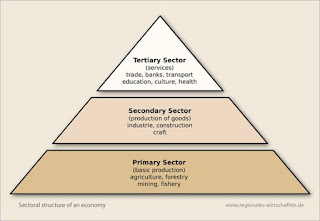UK Economy
-7th largest in the World
-3rd largest in Europe-one of the most globalised countries
-London is the largest financial centre equal with New york
-Largest industries-aerospace, pharmaceuticals, North Sea oil and gas.
What is an industry sector?
-Good-producing segment of an economy
-An area of the economy in which businesses share the same ore a related product or service.
-An industry or market sharing common characteristics.
-Standard economic modules identify four industrial sectors.
http://www.google.co.uk/
Primary sector - The primary sector of the economy extracts or harvests products from the earth.
Secondary Sector - The secondary sector of the economy manufacturers finished goods.
Tertiary Sector - The tertiary sector of the economy is the service industry; transportation, retail.
http://www.regionalentwicklung.de/
Quaternary Sector - The quaternary sector of the economy consists of intellectual activities.
Why are industry sectors important?
Dividing an economy up into sectors with defined similarities, allow for more depth analysis of the economy as a whole.
Why do you need to be aware of economic sectors?
Competition, current market, trends, gaps in the market, understand the relationship between the sectors, see where the money is.
The service industries
-An industry made up of companies and organisations that primarily generate revenue through providing often intangible products and services.
-Service industry companies are involved in retail, transport, distribution food services as well as other service dominated business.
-Service industries can be divided into 3 further sectors.
Public Sector
The part of the economy concerned with providing basic government, state or publicly renowned services. Usually provides services that are free at the point of delivery and a non-payer cannot be excluded from. eg. emergency services. Meant to benefit the whole of society rather than just the individual who uses them. eg. NHS. Support and encourage equal opportunities, for example, public education.Essentially funded by the tax payer.
http://en.wikipedia.org/wiki/Public_finance
vs.
Private Sector
Not controlled by the state. Run by individuals and for-profit businesses. Where most jobs are held. Biggest sector. Differs from other countries. Government have power over economy like the people's Republic of China. National economy is driven by private enterprise and investment. Includes personal sector (household) and the corporate sector (companies). Third Sector
Includes voluntary or not-to-profit companies. Shows how healthy the economy is.
http://www.rdjconsultants.com/third_sector.html
Service Industries
-Creative Industries
-Education, health and social work
-financial and business services
-Hotels and restaurants
-other social and personal services
-Public administration and defence
-Real estate
-Tourism
-Transport, storage and communication
-Wholesale and retail trade
The creative industries
A range of economic activities which are concerned with the generation or exploitation of knowledge and information. Using creative skills to contribute to society, to make money.
For example:
-Advertising
-Architecture
-Crafts
-Design fashion
-Radio
-Film Industry
-Animation
-Post Production
-Graphic Design
http://www.innovateuk.org/creativeindustriesstrategy09/3/3.ashx
"Design is the thread that connects ideas and discovery to people and markets"
The business of Design
The Design Council 2005
Design & Industry
-185,500 designers are generating 11.6 billion in annual turnover
-62% of designers are under 40
-31% (20,436) of design businesses are based in London
-69% isn't
-59% of design companies employ fewer than 5 people
-Over 50% of UK design businesses work in communications, digital and multimedia design.
Working in the Creative Industries
There are 3 main types of companies working in the creative industries.
-Design studios/consultancies
-In-house design teams
-Freelance designers
Disciplines in the creative industries
-Communication design
-Product and industrial design
-Interior and exhibition design
-Fashion and textile design
-Digital and multimedia design
-Service design
-50% of designers working in communication design also work in digital and multimedia design.
-These 2 areas are the most integrated disciplines within the creative industries
-They service all sectors of local, regional, national and international economic sectors.
Organisations to be aware of within the Creative Industry
-Creative England
-Creative & Cultural
-Creative coalition campaign
How the money flows through the government
Driven through profit? Voluntary?
Treasury and civil service sit separately to the government. Work out how much goes to which services.
Special Interest Groups
Create opportunities and feeds in organisations with the money that has been handed down.







No comments:
Post a Comment